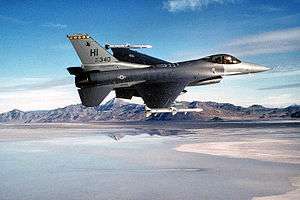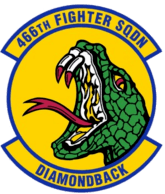466th Fighter Squadron
466th Fighter Squadron
 | |
|---|---|
 | |
| Active | 1944–1945; 1952–1956; 1972–present |
| Country |
|
| Branch |
|
| Role | Fighter |
| Part of | Air Force Reserve Command |
| Garrison/HQ | Hill Air Force Base |
| Nickname(s) | Diamondbacks |
| Decorations | Air Force Outstanding Unit Award[1][note 2] |
| Insignia | |
| 466th Fighter Squadron emblem (approved 29 March 1995)[1] |
 |
The 466th Fighter Squadron is the 419th Fighter Wing's operational flying squadron. It is located at Hill Air Force Base, Utah.
The squadron was activated late in World War II. Intended as a long-range escort unit, it deployed to the Pacific, but remained in Hawaii until it was inactivated after VJ Day. The squadron was reactivated in 1952 as the 466th Fighter-Escort Squadron, but was inactivated in 1956, when the concept of fighters escorting formations of bombers no longer jibed with United States military thinking.
Overview
The 419th uses 15 F-16C/D model aircraft, which are light, air-to-air daytime fighters. The 466th Fighter Squadron first saw action in 1998, participating in Exercise Cope Tiger. This is a drill which puts reserve pilots shoulder to shoulder with members of the Thailand and Singapore Air Forces. Later that year, the 466th was deployed to Kuwait in time for Operation Southern Watch. The 466th was part of a unit attempting to hold off Iraqi movements toward Kuwaiti and Saudi Arabia.
History
World War II
Formed in late 1944 under Second Air Force as one of the last Republic P-47 Thunderbolt fighter squadrons,[1] programmed for deployment to Western Pacific theater with long-range P-47N for Boeing B-29 Superfortress escort missions. Arrived in Hawaii in early 1945, assigned to Seventh Air Force. Lack of a serious fighter defense over Japan at high altitudes and reprogramming of B-29 raids over Japan to night low-level fast attacks led to reassignment as an air defense and training unit in Hawaii.[1]
Early Cold War fighter escort
Reactivated as the 466th Fighter-Escort Squadron to accompany formations of Strategic Air Command Boeing B-50 Superfortress and Convair B-36 Peacemaker bombers. Twice deployed to Japan to augment air defense forces there.[1] Inactivated in 1956[1] with the phaseout of the escort mission and retirement of the B-36.
Reserve fighter operations
Activated again in the reserve as the 466th Tactical Fighter Squadron in 1972 as an Republic F-105 Thunderchief squadron,[1] being equipped with aircraft returned from inactivated Vietnam War squadrons. Since 1984 has trained to fly interdiction, close air support, and counter-air missions. Deployed periodically for contingency operations, or for training exercises with other units.[1]
Lineage
- Constituted as the 466th Fighter Squadron on 5 October 1944
- Activated on 12 October 1944
- Inactivated on 25 November 1945
- Redesignated 466th Fighter-Escort Squadron on 19 June 1952
- Activated on 1 July 1952
- Redesignated 466th Strategic Fighter Squadron on 20 January 1953
- Inactivated on 11 May 1956
- Redesignated 466th Tactical Fighter Squadron on 23 June 1972
- Activated in the reserve on 1 January 1973
- Redesignated 466th Fighter Squadron on 1 February 1992[1]
Assignments
- 508th Fighter Group, 12 October 1944 – 25 November 1945
- 508th Fighter-Escort Wing (later 508th Strategic Fighter Wing), 1 July 1952 – 11 May 1956 (not operational until September 1952)
- 508th Tactical Fighter Group, 1 January 1973
- 301st Tactical Fighter Wing, 25 March 1973
- 508th Tactical Fighter Group, 17 October 1975
- 419th Tactical Fighter Wing (later 419th Fighter Wing), 1 October 1982
- 419th Operations Group, 1 August 1992 – present[1]
Stations
|
|
Aircraft
- Republic P-47 Thunderbolt, 1944–1945
- Republic F-84 Thunderjet, 1952–1956
- Republic F-105 Thunderchief, 1973–1984
- Lockheed T-33 T-Bird, 1973–1980
- General Dynamics F-16 Fighting Falcon 1984-2017
References
- Notes
- ↑ Aircraft is General Dynamics F-16C Block 30J Fighting Falcon serial 87-340 flying a training mission. The 466th is the only Air Force reserve fighter squadron in Utah. This image was used in the April 2000 Airman Magazine article, "High-fivin' 'n' Huggin'" and was taken on 1 April 2000
- ↑ This replaced an emblem approved for the 466th Strategic Fighter Squadron on 23 September 1953. Maurer, Combat Squadrons, pp. 572-573
- Citations
Bibliography
![]()
- Maurer, Maurer, ed. (1983) [1961]. Air Force Combat Units of World War II (PDF) (reprint ed.). Washington, DC: Office of Air Force History. ISBN 0-912799-02-1. LCCN 61060979. Retrieved December 17, 2016.
- Maurer, Maurer, ed. (1982) [1969]. Combat Squadrons of the Air Force, World War II (PDF) (reprint ed.). Washington, DC: Office of Air Force History. ISBN 0-405-12194-6. LCCN 70605402. OCLC 72556. Retrieved December 17, 2016.
- Ravenstein, Charles A. (1984). Air Force Combat Wings, Lineage & Honors Histories 1947-1977 (PDF). Washington, DC: Office of Air Force History. ISBN 0-912799-12-9. Retrieved December 17, 2016.
External links
- 419 Fighter Wing factsheet
- 466th Fighter Squadron info at global security.org